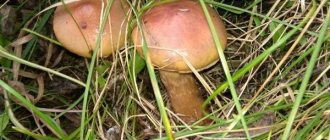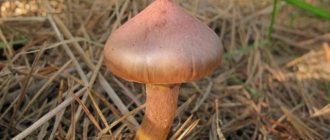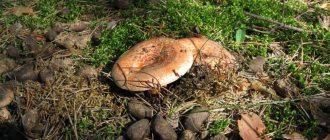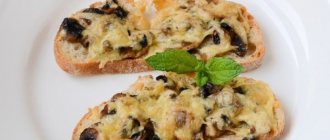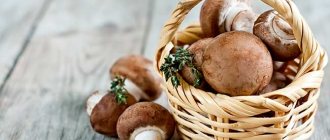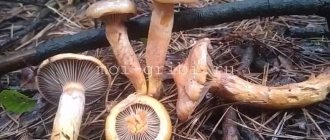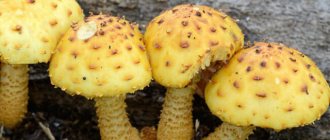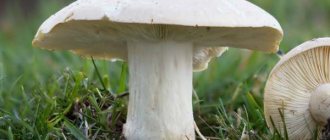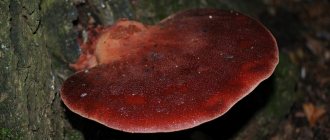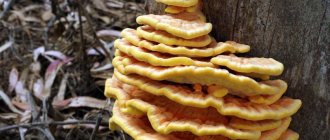In Russian forests you can find 6 species of midge. They belong to the section of lamellar mushrooms. Of course, these mushrooms are not as popular as boletus or boletus mushrooms. However, the percentage of useful substances in them leaves even porcini mushrooms behind. One of the species is spruce moth . It is also called slug, wet goo. It received such names due to the abundant layer of mucus that covers the fruiting body.
The mushroom cap is gray-brown with a purple tint. It is slightly depressed in the center or has a small bump. Its diameter sometimes reaches 12 cm. The edges of the cap are downward, and it itself is dense and covered with a thick layer of mucus. Its flesh is white or pinkish in color, with a sour taste and a subtle odor. It is meaty and juicy, like the same butter dish. The cap of old mushrooms has dark specks.
The plates of sticky moth are sparse and branched. In young mushrooms they are white and covered with mucus. With growth, the mucous membrane comes off and envelops only the leg. Old mushrooms have almost black plates.
The mushroom stem is massive and can reach 12 cm in length. It becomes denser at the base, and there it changes color to bright yellow. Its surface is mucous, like that of the cap. The spore powder is almost black in color. Despite the fact that the appearance of spruce moth is not very appetizing, it is considered an edible mushroom and, in terms of taste, belongs to category 4.
Mushroom habitat: Temperate zone of Russia. In the spruce forests.
Harvesting time: July to November
Edible. Used for frying, salting, pickling. Pre-boiling is not necessary.
How to collect and store
Spruce weed grows from July to the end of October (it is less common in early November) in forests with coniferous trees (mainly spruce), and is sometimes found in mixed forests. The highest fruiting is observed from mid-August to the end of the first autumn month. A lot of wet things come out after a lot of rainfall.
The mushroom is quite common in the central and northern regions of Russia. It grows next to spruce, and in some cases – with pine. It is found both in grass under sunlight and in dark places among moss. Spruce moths grow in groups. They can often be found in the vicinity of boletus.
A significant advantage is that the slug does not have poisonous counterparts. In rare cases, it can be confused with other similar mushrooms that are also edible:
- Mokrukha spotted. Its flesh has a red tint at the break. The cap has dark spots, and the spore powder is olive in color.
- Wet purple. The flesh of the mushroom has an orange-brown tint, its plates are dark purple.
- Butter. Mokruhi with dark caps resemble ordinary buttermilk, but the latter do not have plates.
It is important to remember the following rules before going into the forest for mokrukha:
- The mushroom must be carefully cut with a knife so as not to damage the mycelium.
- It is better to collect moths in a separate basket, as they can turn nearby mushrooms purple. In general, the entire crop must be collected separately by type.
- You should not collect too old specimens. They may turn out to be rotten. It is necessary to check the mushroom for worms.
- You need to collect moths early in the morning, when they have not yet spent all the moisture. This way the product retains more useful components.
- A good harvest can be harvested after the warm rain that fell the night before. After dry weather, it is best not to collect slugs.
It is advisable to process the prey on the day of collection, so the mushrooms will not spoil and will retain their beneficial properties. It is necessary to sort through the wetlands, clean them of dirt, soil and pine needles. Selected mushrooms are stored in a cool place. You can freeze slugs. In this form they are stored for 10-12 months. Before this, they must first be boiled.
Varieties of mokrukhs: what are the differences
Mushrooms from this group differ slightly from each other in the shape and color of the cap, as well as in their size and distribution areas.
One of the most popular mokruhas among all is spruce, popularly known as sticky. It is recognized by the grayish or bluish color of its cap. It usually grows in groups in the shade of spruce trees, although sometimes it is found near pine trees, in mixed forests, among heather. The fruiting season of spruce moths sometimes lasts until the first frost, although the peak occurs in the second half of August and September. Many of these organisms are found in the northern and central parts of Russia, in northern Finland. Their flesh is quite tasty, but due to their very fragile texture, these mushrooms are difficult to pick, much less peel and cook.
Pine fly is also called shiny, purple or yellowlegged. Slightly different from the “sisters” in a purple hat with slightly turned up edges. This species prefers temperate climates and, as the name suggests, pine forests, where it can be seen from mid-summer to October. Sometimes mokrukha take root in the vicinity of birch trees, and from among other mushrooms, boletus is usually chosen as a neighbor. Like spruce trees, they can grow alone or in large groups. The taste of the pulp resembles pink and spotted. Purple moths are common in North America, Canada, Eastern and Western Europe, and the European regions of Russia, but most of these mushrooms are found in Siberia and the Caucasus.
The spotted or slimy one differs from other varieties by its smaller cap, on which dark spots are clearly visible. In places of damage, the spotted fly turns red. Prefers to grow in symbiosis with larches or spruces. In Russia, this species is less common than others, but slimy moths are “residents” of almost all coniferous forests of North America and some regions of Eurasia.
Many mushroom pickers call felted mucus fluffy. This name fully corresponds to it: the whitish cap of the mushroom is covered with soft fluff. As a rule, it “settles” near black fir trees. Most often it can be seen in the forests of North America and the Far East. It is quite rare in Europe.
Pink morukha differs from other varieties in its bright cap. Since it almost always grows in symbiosis with the goat, experts suggest that the moth is a parasite on its mycelium. In Europe, this mushroom has endangered status, and in Bulgaria, Poland, Belgium and Hungary it is listed in the Red Book. It is also a rare guest in the forests of Asia. Experts have determined that pink moths grow best in regions with snowy winters and hot but short summers, although not everywhere.
The Siberian moth is often called the edible counterpart of the felt moth. It, like the fleecy variety, is also covered with fluff, but its cap is not white, but in grayish shades. Swiss weed is a conditionally edible variety of mushroom. Its flesh is quite tough and fibrous, with a sweet aftertaste. As a rule, it grows in mountain forests near cedars or spruces.
Use in cooking. Recipes
In Europe, spruce moth is considered a tasty product, and in China it is consumed more often than other mushrooms; in our country it is not very popular. Sticky mokrukha can be salted, fried and pickled. It is also suitable for drying. It is used to make soups, sauces, casseroles, and sandwiches. Spruce moth can be added to salads, fried or boiled. It will give the dish a special taste and make it visually attractive.
They prefer to use it as an addition to main dishes, mixing it with other mushrooms. It goes well with meat or fish if fried or stewed with other more flavorful foods.
Before use, freshly picked mushrooms are sorted and damaged mushrooms are discarded. It is advised to remove all film and mucus. To do this, you need to cut the leg in half lengthwise up to the cap, then it will be very easy to remove the unnecessary skin.
Mushroom pickers recommend putting mushrooms in water for a few minutes before cleaning. Then the layer of mucus will be removed even easier. The fingers darken during cleaning, but after the procedure they can be easily washed with soap and water. Then the mushrooms are washed and cooked for about 15-20 minutes. After heat treatment, the product darkens; this color change does not affect the taste of the product.
If mushrooms are fried, do not add a lot of oil, because the pulp will give juice, which is enough for subsequent processing. For those who like crunchy and strong mushrooms after frying, mokruki are not suitable. You shouldn’t simmer sticky mokrukha for too long, because the flesh will become tough.
How to pickle Mokrukha
Mushroom pickers advise pickling slugs along with other mushrooms. So, for 1 moth there are 8-10 butterflies or cobwebs.
The following marinating recipe has worked well:
- Peeled mushrooms should be placed in a deep container and filled with water, adding a pinch of salt and the same amount of citric acid. The mixture is brought to a boil and cooked for 15-20 minutes.
- The water is drained and the mushrooms are washed. Now they are ready to marinate.
- Pour 1 liter of water into the pan and add 80 g of sugar, 5 black peppercorns, 2 cloves, 50 g of salt, 100 ml of 6 percent vinegar and one laurel leaf.
- The resulting marinade is brought to a boil and 2 kg of prepared mushrooms are added to it. Cook everything together for 20 minutes.
- When the mushrooms sink to the bottom and the water becomes clear, they are transferred along with the marinade into pre-prepared jars, filling with liquid so that it completely covers the mushrooms with butter.
- Add 1 tablespoon of sunflower oil to each jar and close with nylon lids. Store pickled mushrooms in the refrigerator.
Below are other recipes using wet glue:
Korean snack
Very fast and tasty.
To prepare this dish, you need to carefully separate the mushrooms from the film and boil. Then the mushrooms are fried along with chopped onions. Korean carrots are added to the finished products, preferably not spicy ones. The dish is seasoned with olive oil.
Peppers stuffed with mushrooms and buckwheat
Most housewives are accustomed to stuffing bell peppers with rice and meat. You can diversify the menu by replacing the filling with buckwheat and spruce moths. To do this, you need to boil and fry the mushrooms a little. Then they should be mixed with raw buckwheat, salt and pepper to taste. The resulting mixture is used to stuff peppers, which must be seeded in advance. Vegetables are stewed in water with the addition of tomato paste, or fried with fresh tomatoes.
Bachelor Sandwiches
This is a very simple recipe that even a child can handle. You need to fry a few slices of bread and spread a little butter on them. Peeled mushrooms are boiled and fried in a frying pan for 3-4 minutes. Place toasted mokrukha on the bread and sprinkle grated cheese and herbs on top. Sandwiches should be placed in the microwave for 1-2 minutes to melt the cheese.
Due to its low calorie content and large amount of useful substances contained in this product, nutritionists recommend spruce moth for daily use. In terms of protein content, it can become a good competitor to meat dishes.
Was there an orange in medieval Russia and Europe?
The above book uses orange peel. Many may wonder: “Where were the oranges from in those days?” However, since the time of Peter the Great, orange greenhouses (German name: Oranienbaum) appeared - this is what the greenhouses of those years for growing orange were called. Thanks to Prince A.D. Menshikov, this hobby passed on to almost all the nobility of those years. Later, the French name for "orange" was replaced by the Dutch appelsien (translation: Chinese apple).
Initially, oranges grew only in Southern China, from where they came to Egypt and Syria. During the Crusades they were brought to Europe. Thus, the people of those years, in particular the nobility who lived on the territory of the Russian Empire, knew the taste of this wonderful fruit.
Medicinal uses and beneficial properties of the mushroom
Slug is considered one of the most useful types of weevils, because it is very rich in carbohydrates and amino acids. It contains vitamins of group B, as well as C and E, necessary for humans. It contains chitin and fiber. All these substances have a beneficial effect on the human body, namely:
- increase body tone;
- improve memory;
- fight fatigue;
- promote the process of hematopoiesis.
This product is especially useful for people who suffer from headaches, chronic fatigue, and diseases of the nervous system.
A tincture is made from spruce moth, which is used as an antimicrobial agent. It has a strong suppressive effect on the proliferation of various pathogenic microorganisms, including staphylococci. It is used to treat skin diseases, sinusitis, wound healing and rinsing the mouth. However, such a medicine has not undergone clinical trials, its effect has not been scientifically confirmed.
Traditional healers offer the following recipe for tincture:
- The wet ones are cleaned of dirt, but not washed. This will preserve the mucus, which contains substances beneficial to the body.
- Then they are finely chopped and placed in a glass container. There is no need to compact the mushrooms to the top.
- The product is poured with high-quality vodka or alcohol and placed in a dark place for 2 weeks. The composition should be infused at room temperature. It is necessary to shake it periodically.
- After the specified period of time, strain the tincture using gauze and squeeze out the mushrooms.
- The resulting product is stored in a place protected from sunlight and also at room temperature.
Take it 20 drops three times a day, washed down with water or added to liquid. Children under 12 years of age are allowed to take the medicine. Then the dosage is reduced to 3-7 drops, depending on age. The tincture is also used to wipe sore spots on the skin.
Slug extract is well known to experienced cosmetologists. It can be found in some masks and creams. Such products help restore youth and freshness to the skin. Masks with an extract of this mushroom can tighten pores, eliminate oily shine and remove flaking.
Masks made from crushed spruce dust are good for hair that has split ends. It is useful to rinse weakened and dull hair with a decoction of them. Regular use of this mushroom will even help you cope with baldness.
Growing at home and in the country
Spruce weed can be grown in your own garden plot by sowing mycelium near spruce and pine.
Procedure:
- The mycelium is mixed with half a kilogram of sand or dry soil.
- First you need to make small grooves or depressions in the ground (about 10 cm deep).
- Spread the mycelium evenly over the surface. To calculate its quantity, you should adhere to the formula - 1 package: 1 m².
- The area is sprinkled with soil (compost and soil in a 1:1 ratio).
- Cover with spruce or pine needles.
- Watering is done once a week; you will need 10 liters of water per 1 m².
The first harvest can be expected 2 months after sowing.
Interesting to know! Spruce weed can bear fruit (give a harvest) up to 4 times a year!
Harm and contraindications
Any edible mushrooms are a difficult product for the stomach. Therefore, it is not recommended to consume spruce moth for people with chronic gastrointestinal diseases, serious liver and kidney diseases. This is due to the presence of fiber and chitin in mushrooms, which can cause the development of pancreatitis and gastritis. Spruce weed can aggravate the situation with gout.
Children under 10-14 years of age, pregnant and lactating women should not consume slug. Individual intolerance to the substances that make up the fungus can cause allergic manifestations. In any case, it is better to consult a doctor and find out whether this product can be introduced into your diet.
You should eat only those moths that are collected in environmentally friendly places. It is important to prepare the product correctly by pre-cooking it. This will reduce the risk of developing digestive problems.
Conclusions about spruce weed:
Many mushroom pickers believe that spruce moth is difficult to collect, clean and cook due to its fragile texture, so they prefer to collect other mushrooms in the forest. However, the unsightly appearance and not very expressive aroma are compensated by the presence of a large number of useful substances, which the sticky mocha is so rich in. It is not for nothing that forest dwellers such as squirrels love it very much.
Spruce weed is one of the most common species of the genus of the same name. This edible mushroom with high nutritional value has characteristic differences that are important to know before harvesting.
Description of types of moths
There are currently six varieties of such mushrooms growing in our country, but the most common are spruce, pink and purple mushrooms.
Spruce damp (sticky)
Gomp.glutinosus is an edible variety characterized by a hemispherical, convex-conical, prostrate or slightly depressed cap in the central part, with the presence of an inconspicuous tubercle.
It is distinguished by a smooth, distinctly slimy, shiny surface of gray, grayish-bluish-blue or grayish-brown skin, which is easily removed with fleshy and fragile, white or pinkish pulp, which has a slightly sweetish or sour taste and an inexpressive mushroom aroma. The plates are descending, arcuate, with strong branching, grayish or whitish. The leg is tall and massive, with a club-shaped base, whitish-grayish, mucous, with the presence of an indistinct mucous ring.
Spruce damp (sticky)
Purple wetter (yellow-legged)
Сhr.rutilus is an edible variety characterized by a conical-rounded, flat-convex or prostrate cap, with a wide and blunt prominence in the center, covered with a smooth and shiny, highly mucoid, light brown, reddish-brick-red or lilac-reddish skin , covering fleshy, pinkish-yellowish flesh without a strong odor or pronounced taste.
The plates are arched, descending, sparsely spaced, thick, ocher-pink or mauve, purple-brown or dirty brown, almost black. The leg is solid, cylindrical in shape, tapering at the base, slightly sticky, with ring-shaped remains of the veil.
Purple wetter (yellow-legged)Wet pink
Gomp.roseus is an edible variety characterized by a hemispherical, convex or flattened, slimy cap with rolled up or raised edges, coral-pink or brick-pink coloring with sparse, descending on the stem, branching, ash-gray and dark grayish with greenish or lilac shade plates. The leg is cylindrical, narrowed at the base, pinkish-whitish, with a mucous-type ring. The soft part turns pink when cut, has a whitish color, with a weak and pleasant aroma, as well as a sweetish aftertaste.
Wet pink
Mokrukha spotted
Gomp.masulatus is an edible variety characterized by a convex, flattened or sometimes slightly depressed cap with rolled edges, covered with mucous, pale, pink-brown, grayish-ochreous or yellowish skin. The plates are sparsely spaced, descending, branching, whitish or dirty brown in color. The stalk is cylindrical, fibrous type, with an adhesive surface and a mucous-type ring. The soft part is whitish or yellowish, turning red when cut.
Mokrukha spotted
Mokrukha felt
Сhr.tоmentosus is an edible variety, characterized by a convex, flattened and sometimes depressed, with a blunt tubercle in the center and pubescent, curled edges of the cap, covered with a dry, fibrous, slightly sticky, yellowish-brown or ocher skin. The plates are sparse, descending type, dirty brown in color. The leg is cylindrical, fibrous, with the presence of a cobwebby ring. The soft part is ocher colored, with a wine-pinkish tint.
What do spruce moth mushrooms look like?
According to the description and photo, the spruce moth has a hemispherical cap. The diameter of the surface of the mushroom is from 4 to 10 cm. At a young age, the ends of the cap are tucked towards the stem, but over time the surface of the spruce moth acquires a convex-conical, and then an outstretched shape with an inconspicuous tubercle in the center.
The hat can be gray with a brown or blue tint in the center and purple around the edges. The smooth skin of the spruce moth is covered on top with a thick layer of mucus, which is why the mushroom begins to shine and appears wet.
The edges of the cap of young specimens are connected to the stem by a thin mucous membrane. It looks like a colorless film formed by thread-like fibers, which begins to tear as the fungus grows. The bedspread peels off and remains hanging on a high, massive leg. Subsequently, black inclusions appear on the surface of the spruce weed.
Under the cap there are a sparse layer of descending arcuate plates of grayish or white color, from 3 to 6 mm in width. In young specimens they are covered with a mucous membrane. With age, the plates acquire a brown tint, after which they become purple, almost black.
In young specimens, the leg is thick, slightly swollen, from 5 to 11 cm. As it grows, it acquires a cylindrical shape, and its base becomes narrowed. It has a solid structure and a smooth surface of bright yellow or lemon color.
Spruce weed is characterized by elongated fusiform or cylindrical spores. Their surface is smooth, brown, with 1-2 oily drops.
The pink flesh becomes grayish as the moth grows. The structure of the fruit body is fleshy, but fragile.
general characteristics
Under the general name “mokruhi”, experts have combined two genera of agaric mushrooms: grogomphus and gomphidius, which, however, have much in common.
These mushrooms got their not very appetizing name because of their specific appearance. Their caps are always wet and covered with a slimy layer. And although boletus, beloved by many, has similar characteristics, mushroom pickers (especially inexperienced ones) look at wet mushrooms with caution. Some varieties of mokrukhs have common features with goat mushrooms, but if the goat mushroom belongs to the tubular mushrooms, then all mokrukhs are lamellar. The plates under the cap of most moths are white, sparse, and darken in the places where they transition to the stalk. Young mushrooms are usually covered with a very thin layer of mucus. On older ones, the mucus slides down the stem in clumps.
Almost all mokrukhas are quite large mushrooms that can grow 12 cm in height and have about the same cap diameter. Depending on the variety, the caps of young moths come in different shapes. Spruce, spotted and felt ones have convex ones, pine and pink ones have conical ones. Almost all older representatives have caps that are straight and have a slight sag in the center. The pulp of different species of this mushroom family also differs. Spruce and spotted ones, for example, have white-gray flesh, pine ones are recognized by their orange-brown flesh (it turns red when exposed to air), felt ones have ocher flesh with a wine-pink tint, pink ones have white flesh, which quickly turns pink in places of damage.
The legs of all varieties of the mushroom are white-cream and quite massive with a thickening at the base. They, like the caps, are covered with mucus. Closer to the top, a ring of mucus forms on the legs. The flesh of the legs is dense, yellow below and gray-white closer to the cap. Most moths prefer coniferous forests and moss-covered areas. They grow both in families and alone. The first slimy mushrooms appear in July, and the fruiting season lasts until mid-autumn.
Experts distinguish many varieties of moths, but not all of them are edible. As a rule, only 5 of them are eaten:
Rarer specimens (due to their limited range) are the Siberian and Swiss midges. According to the classification of edibility, all moths belong to category 4. This means that the mushroom is edible, but only after preliminary heat treatment. There are 6 varieties of these mushrooms found in Russia, but the most common are spruce, purple and pink.
Benefits and harm to the body
Spruce moth is considered one of the most useful species due to the high content of carbohydrates and amino acids in its composition. Fruit bodies are rich in vitamins C, B and E, chitin and fiber. All these components have a beneficial effect on body systems:
- increasing its tone;
- helping to improve memory;
- eliminating chronic fatigue;
- improving the process of hematopoiesis.
The use of the product is especially useful for those who suffer from headaches or have diseases of the nervous system.
The mushroom is used to prepare an antimicrobial tincture. This product prevents the proliferation of pathogenic microorganisms. In addition, spruce moth is actively used to eliminate skin diseases, sinusitis, heal wounds, and also for rinsing the mouth.
Masks with spruce dust will be useful for split ends, and for weakened and dull hair, rinsing with a decoction of the mushroom is suitable. Regular use of such products helps stop hair loss and even prevent baldness.
Despite all their nutritional value, most edible mushrooms are a rather difficult product for the body. That is why the use of spruce moth is contraindicated for people with diseases of the gastrointestinal tract, liver and kidneys. This is due to the fact that fiber and chitin can provoke the appearance of pancreatitis or gastritis. In addition, the fungus can increase the development of gout.
Spruce fly should absolutely not be given to children under 10-12 years of age, as well as during pregnancy and breastfeeding. If you are hypersensitive to substances in the product, an allergic reaction may occur.
Only specimens collected in environmentally friendly areas are allowed to be used for food. Preliminary heat treatment of fruiting bodies will significantly reduce the risk of problems with the gastrointestinal tract.
Chemical composition and calorie content
The photo, description and preparation of the mokrukha mushroom are of interest due to the rich chemical composition of the product. The pulp of the fruiting bodies contains:
- proteins and amino acids;
- vitamin PP;
- ascorbic acid;
- vitamins B1 and B2;
- tocopherol;
- carbohydrates and fats;
- organic acids;
- mineral components.
We recommend reading: Acacia catechu: description, benefits, use of the extract
The energy value of the mushroom is low - only 19 calories per 100 g. About 3.2 g of the composition are carbohydrates, another 0.9 g and 0.4 g are proteins and fats.
False doubles
The spruce fly does not have poisonous counterparts, which is a great advantage of the species.
Sometimes it can be confused with similar-looking edible varieties:
- Mokruha is spotted: the fracture of its flesh has a red tint, and there are dark inclusions on the surface of the mushroom.
- Another edible doppelgänger is the purple moth. It is distinguished by orange-brown flesh and dark purple plates.
- Often, because of the dark cap, spruce fly is confused with boletus, but the latter do not have plates.
How to distinguish a serushka from false serushkas
Serushki grow in large clusters forming rounded rows, which is why they are called “witch circles.” To avoid getting poisoned, you should know how to distinguish conditionally edible earrings from their counterparts, which pose a serious threat to life and health:
- White poisonous row. Its flesh, painted white or milky, acquires a pink tint when broken. The stem and cap are white. A distinctive feature is a pungent odor reminiscent of radish.
- Inedible soap semolina. It is characterized by a sharp soapy odor and has a uniform, rich color.
- Pointed earring. It has a very pungent taste and repulsive odor. It is easily distinguished from the real variety by the presence of a high, pointed part in the center of the cap.
All types of false mushrooms can be identified by one common distinctive feature: when broken, representatives of the species emit a sharp, unpleasant odor, and some mushrooms have a repulsive smell even in an untouched state.
Collection rules
To avoid negative consequences, you must adhere to the main rules for collecting spruce bits:
- The fruiting body is carefully cut off with a sharp knife so as not to damage the structure of the mycelium.
- It is best to place mushrooms in a wicker basket so that they do not turn the specimens lying nearby purple. The best option is to sort mushrooms by type.
- Old moths should not be cut off as they may be rotten inside. Collected specimens must be checked for worms.
- It is best to start harvesting in the morning, before most of the moisture has evaporated from the mushrooms. This way, mokruki will retain a maximum of useful substances in their composition.
- The optimal time for harvesting mushrooms is after warm rain. It is not recommended to go out on a “quiet hunt” in dry weather.
It is important to process the collected mushrooms as soon as possible so that they do not spoil and retain their beneficial properties. Spruce bits are carefully sorted and cleaned of dirt, earth clods and pine needles. Afterwards, it is better to place the raw materials in a cool place. For long-term storage, mushrooms can be placed in the freezer. When frozen, fruiting bodies can be stored for 10 to 12 months.
Purple wetter (yellow-legged)
Сhr.
rutilus is an edible variety characterized by a conical-rounded, flat-convex or prostrate cap, with a wide and blunt prominence in the center, covered with a smooth and shiny, highly mucilaginous, light brown, reddish brick-red or lilac-reddish skin covering fleshy, pinkish-yellowish pulp without a strong odor or pronounced taste.
The plates are arched, descending, sparsely spaced, thick, ocher-pink or mauve, purple-brown or dirty brown, almost black. The leg is solid, cylindrical in shape, tapering at the base, slightly sticky, with ring-shaped remains of the veil.
Purple wetter (yellow-legged)
How to cook spruce mokruki
Spruce moss is salted, fried, pickled, and also dried. The mushroom is used to make soups, sauces, casseroles and sandwiches. Fried or boiled fruit bodies are added to salads. Mokrukha in combination with other types of mushrooms is also used as an addition to main dishes. It goes especially well with meat or fish. No less popular are recipes for canning spruce dust.
Before peeling mushrooms, they need to be placed in water for 5-7 minutes: then the mucous membrane will be much easier to remove. After cleaning, the fruiting bodies should be thoroughly washed and boiled over fire for 15-20 minutes. Heat treatment changes the color of the mushroom to a darker one, but this does not in any way affect the taste of the product.
Frying spruce moths does not require a lot of oil, since their pulp itself releases a sufficient amount of juice. You should also not stew mushrooms for a long time, this will make them tough.
Distribution area
Sandstone mushrooms are quite rare mushrooms; they are not found in all countries, usually in the steppe and forest-steppe zones. They grow in regions with temperate climates: Canada, North America, Asia, Europe. In Russia, they are especially common in the Voronezh, Volgograd, Rostov and Saratov regions, Kazakhstan, Altai Territory, and Siberia. They prefer deciduous and mixed forests. But they grow only on dry, loose soil, often on sandy soils, which other mushrooms do not like.
They are found mainly under trees, preferring poplars, aspens, and conifers. But you can find them in open areas, on the edges, along roads, near tree stumps, along the banks of rivers and ravines. It is difficult to detect them, as they like to camouflage themselves by hiding in the ground. The hats are always covered with sand, covered with blades of grass and leaves.
Recipes for spruce weeds
There are many different options for preparing spruce dust. Among them, everyone can find the most suitable one for themselves. All of them are easy to perform.
Pickled spruce moths
- 2 kg mokrukh;
- 2 cloves;
- 70 g sugar;
- 50 g salt;
- 100 ml 6% vinegar;
- black pepper;
- Bay leaf;
- sunflower oil;
- 1 liter of water.
- Peel the mushrooms, place in a deep container and add a small amount of water, adding a pinch of salt and citric acid. The mixture should be brought to a boil and cooked for 15-20 minutes.
- Drain the water and rinse the fruiting bodies thoroughly.
- Fill a saucepan with water, add sugar, black pepper, cloves, salt, vinegar and bay leaf.
- Bring the resulting mixture to a boil and add 2 kg of peeled spruce chips. Cook on fire for 15-20 minutes.
- When the fruiting bodies settle to the bottom, they need to be transferred along with the marinade into prepared jars. The liquid should completely cover the mushrooms.
- Add 1 tbsp to each jar. l. sunflower oil and close with a nylon lid. Pickled mokruhi should be stored in the refrigerator.
Spruce moths in Korean
Mushrooms must be carefully separated from the mucous membrane and boiled. After this, the fruiting bodies should be fried, adding chopped onions and Korean carrots. Season the dish with olive oil.
Stuffed peppers with spruce mokrukha and buckwheat
In addition to the classic version with rice and minced meat, you can use buckwheat and mushrooms to stuff peppers:
- The fruit bodies are boiled and fried for several minutes.
- Then the spruce flour is mixed with buckwheat, salt and pepper to taste.
- The resulting mixture is filled with peppers that have been seeded in advance.
- Add a little tomato paste to a container of water and simmer the peppers for 30-35 minutes until fully cooked.
Bachelor sandwiches
- 2-4 slices of bread are fried in a frying pan. Then spread with a thin layer of butter.
- Pre-peeled and boiled fruit bodies are fried over low heat for 3-5 minutes.
- Mushrooms are placed on bread, sprinkled with grated cheese and finely chopped herbs.
- After this, the sandwiches are placed in the microwave for 2-3 minutes to allow the cheese to melt.
Low calorie content and rich composition of nutrients allow you to consume spruce moths even during a diet. Moreover, in terms of protein content, such mushrooms are not inferior even to meat dishes.
To help the moonshiner, equipment on ALI EXPRESS:
- 50 liter pot still
- Thermometer probe
- Mixing spatula
- Kitchen scales
- Fermentation container
- Water seal for fermentation
- Set of measuring containers
- Hose holder
- Faucet for draining mash
- Aquarium water heater
- Handheld Refractometer with ATC Sugar Meter, Grape Sugar Meter, 0-32% Brix
- Small scales
- Chillers of different sizes
- Tap adapter for moonshiner
- Silicone tubes
- Induction cooker
- Set of glass graduated measuring cylinders 5ml 10ml 50ml 100ml glass with two brushes
- Oak barrel Caucasus 5 liters for infusing drinks
- Coal column
Mokrukha spruce pickling recipes
Pickling mushrooms, such as drying, pickling and freezing, is one of the ways to prepare them for the winter. For pickling, from tubular mushrooms, they use young porcini mushrooms, aspen mushrooms, boletus mushrooms, boletus mushrooms, and from lamellar mushrooms, they use autumn mushrooms, saffron milk caps, boletuses, milk mushrooms, and white mushrooms.
Fresh mushrooms cannot be stored for long, so they need to be sorted, cleaned of debris and salted . When sorting, they are laid out by type: milk mushrooms, boletus, white mushrooms, boletus and so on. Specimens intended for pickling and immediate fresh use are immediately set aside.
If pickled mushrooms will be stored in a cellar at a temperature no higher than five degrees Celsius , for pickling they take 50 grams of salt per 1 kg of mushrooms. If the storage temperature is at room temperature , you should take 100 g of salt per 1 kg of mushrooms. Spices and herbs are added according to your taste. Some housewives use bay leaves, others allspice and black pepper, some put currant leaves, and some, nothing.
To pickle mushrooms, glass jars, enamel pots and buckets, wooden barrels, and so on are used. All salted mushrooms should be kept under pressure.
Dry pickling of mushrooms
Chernushki, saffron milk caps and smoothies can be salted like this: Cut off the stem of prepared mushrooms, place in a container, cover with salt, cover with a napkin, put a circle on top and place a weight. The mushrooms will release juice and settle. As they compact, you can add fresh mushrooms to the container, sprinkling them with salt, until the container is completely filled and the settling of the mushrooms stops.
Mushrooms salted in this way are ready for consumption no earlier than after 35 days.
- Mushrooms – 1 kg
- salt - 50 g
Pickling soaked and boiled mushrooms
Some lamellar mushrooms have a pungent, bitter or unpleasant taste and odor. This can be eliminated by soaking them for two to three days or by cooking. Mushrooms intended for pickling are placed in a bowl and filled with cold, salted water. For 5 kg of mushrooms take 1 liter of water. Cover with a cloth, then with a wooden circle and place a weight on top.
The soaked mushrooms are put in a cold place so that they do not sour. The soaking time, depending on the type of mushroom, ranges from 1 to 3 days. The water should be changed at least once a day.
During the soaking process, mushrooms lose their taste, since water takes away some of the soluble substances from them, so soaking can be replaced by scalding. Mushrooms that have a persistent unpleasant odor and taste must be boiled.
Valui, chanterelles, milk mushrooms, podgruzdi, russula, etc. prepared for salting. immerse in boiling water and cook for 5 to 30 minutes. Honey mushrooms - 15-20 minutes, valui and chanterelles - 30 minutes, bitter mushrooms - 8-10 minutes, white mushrooms and chanterelles are scalded with boiling water. Porcini mushrooms, boletus, boletus and aspen mushrooms are boiled in salted water for 8-10 minutes, after which they are salted in the usual way or pickled.
The water in which mushrooms are boiled is not used for scalding or decoction. It should be poured out. After cooking the mushrooms, the pan should be wiped with dry salt, washed thoroughly and dried with a towel. Pickling mushrooms in this way has its own characteristics for each type.
Pickling porcini mushrooms, boletus, boletus, boletus
The mushrooms are cleaned of dirt, the stems are cut off and cooked in salted, boiling water for 15 minutes. Then, rinse with cold water and place on a sieve, allowing them to dry. Next, the mushrooms are placed in a bowl with their caps up, topped with spices and sprinkled with salt. Cover with a napkin, make a circle and place a weight on top.
- prepared mushrooms - 10 kg
- salt - 500 g
- bay leaf - 20 g
- allspice – 8 g
Salting milk mushrooms and milk mushrooms
The mushrooms are cleaned and sorted, the stems are cut off and soaked in cold water for 2-3 days. After soaking, the mushrooms are thrown into a sieve, allowed to drain well and placed in a barrel, sprinkled with salt and spices. Cover the top with a napkin, place a circle and place a weight.
After salting, the mushrooms will settle, and the barrel can be added. Brine should appear on top. If it does not appear, the load should be added. Such mushrooms can be consumed after 20-25 days.
- Mushrooms – 10 kg
- salt - 400 g
- horseradish root - 20 g
- dill greens - 35 g
- garlic - 40 g
- bay leaf - 10 pcs.
- allspice - 40 peas
Cold pickling of mushrooms
Method 1. Mushrooms are salted raw, after soaking them in cold water and changing it several times: white mushrooms and volnushki - 1 day, saffron milk caps - 4 hours, valui - 2-3 days, milk mushrooms and podgrudki - 2 days. Then pour boiling water over it.
Method 2. The saffron milk caps are not soaked, the milk caps, volushki, milk mushrooms, and podgruzdki are soaked for 5 days, and the valui are boiled.
Method 3. Belyanki, volnushki, milk mushrooms, podgrudki, valui are soaked in salted water for 3 days.
Method 4. Do not soak the mushrooms at all. They are washed well and immediately salted.
Method 5. Mushrooms are not salted raw. They must be boiled. They believe that they become more tender and fragrant.
Cold-salted saffron milk caps can be consumed after 5 days; for other mushrooms the timing is longer: milk mushrooms and podgruzdki are ready after 30 days, valui - after 50, white mushrooms and volushki - after 40.
Hot pickling of mushrooms
The mushrooms are boiled before salting.
Method 1. Butter mushrooms, boletus mushrooms, boletus mushrooms, honey mushrooms, goat mushrooms, boil for 5-8 minutes, white mushrooms, champignons, aspen mushrooms - 8-10 minutes, chanterelles - 12-15 minutes, valui - 15-20 minutes.
Method 2 . Boil russulas, milk mushrooms, milk mushrooms for 5 minutes, white mushrooms, boletus mushrooms, boletus mushrooms, boletus mushrooms for 5-7 minutes.
Method 3. Boletus and boletus are boiled for 1-2 minutes, chanterelles and boletuses - 20-25 minutes, white mushrooms and boletuses are first poured with boiling water, kept in it for half an hour, the water is changed and boiled for 15 minutes.
Hot salted mushrooms are ready to eat in 2-3 days.
Kombucha - care and preparation
Growing Kombucha
It is necessary to very carefully separate one layer from an adult multilayer mushroom. Rinse the resulting separate layer thoroughly in boiled water, and fill a three-liter jar with warm water; its temperature should be within twenty-five degrees.
Cover the jar with gauze. It is not recommended to use the lid, and leave it to get used to for one to two days.
At this stage, under no circumstances should you feed the newborn fungus with either a tea solution or sugar. The mushroom is very sick in the habituation stage, and reacts absolutely to any third-party intervention; it needs some time to take root.
During this time, the mushroom will float along the bottom of the jar or even lie at the very bottom. After time has passed, the mushroom must be transferred to the prepared solution. He will get sick for a while and swim at the bottom or in the middle of the tank.
Be patient. It will definitely pop up, but only if all the requirements are met correctly. It must be bred correctly, since it lives very little, sooner or later you can be left without a mushroom at all.
Kombucha - preparing the solution
Cooking steps:
- For a three-liter jar, it is necessary to prepare no more than two liters of solution, since the kombucha can become very crowded, because it usually floats on top of the container.
- Take twenty grams of leaf black tea and make a brew, strain and pour it into hot or cold boiled water to get a weak tea solution.
- Pour fifty grams of granulated sugar into the solution and mix everything thoroughly until the sugar is completely dissolved.
- The hot solution must be cooled to room temperature. Carefully lower the mushroom into this solution. The optimal temperature for the life of the fungus is considered to be twenty-five degrees Celsius. It can be a little lower, up to seventeen degrees; temperatures lower than that are strictly prohibited.
Everything must be done strictly according to the instructions. For example, it is strictly forbidden to add sugar directly to the container, since undissolved sugar can cause a severe burn to the mucous membrane of the kombucha, which can cause its death. Floating tea leaves will cause no less harm to the mushroom.
It is recommended to place the jar of kombucha in a dark place; direct sunlight can cause irreparable damage to it.
A healthy mushroom floats peacefully on the very surface of the solution, and gradually turns the mixture of tea leaves and sugar solution into a healthy and tasty drink.
Kombucha - feeding
An adult healthy mushroom should be fed regularly and the prepared solution should be systematically drained. In the summer, this should be done once every three to four days, in the winter, once every five to seven days. In order to speed up the fermentation process as much as possible, add one glass of the prepared infusion to the prepared solution.
An adult mushroom processes the infusion faster than a sick or young fungus. It is not recommended to overexpose the infusion, as the top layer will immediately begin to darken, and this may cause the mushroom to die.
Do not forget that the mushroom must be washed in boiled water three times, each time the solution is changed. This must be done very carefully so as not to damage the mushroom.
It is strictly forbidden to use a sweetener or raw sugar instead of sugar, because these actions inexorably lead to the death of the fungus.
The finished infusion can be stored in the refrigerator for four to five months.
